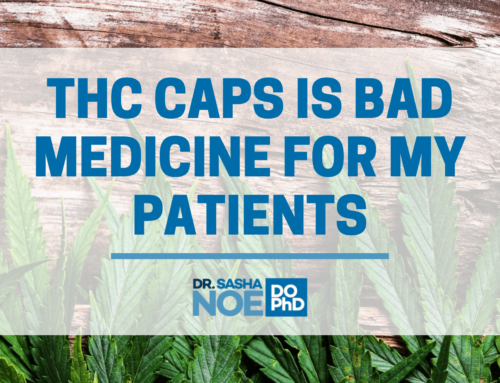Remember the Golden Rule…
The Florida Department of Health will be meeting to address the rules on dosing of medical cannabis. As directed by the Florida law, they must address daily dose amounts and equivalent dose amounts for each allowable form of cannabis dispensed by a medical marijuana treatment center.
As you contemplate this rule let me say this…remember the golden rule…you know how it goes…
It is understood that you’re doing what you are required to do based on a piece of legislation. As a physician on the front lines seeing patients, it is my opinion that the legislation should not be telling physicians how they should do their job to this level of specificity. We already have standards for our profession, standards of care for patients and rules of medical ethics that we are applying and following each and every day to the best of our abilities. This is no different. Yet as I write this I am also aware that there are ‘rule breakers’ out there that make it a nightmare at times for those of us trying to do our jobs and as a result rules exist for this reason.
With medical cannabis, physicians can look at decades of research and make the best decision for their patients. I personally don’t need the department of health to tell me how to do that. However, I understand that they have been tasked with this job by legislators who have a limited understanding of how physicians put medicine and science together on a daily basis. Not to mention, there is truly a concept known as the art of medicine and this happens when we consider each aspect of each patient, individually and on its own merits. This is what we are trying to do with medical cannabis, applying science and medicine artfully, albeit with one arm tied behind our backs. My appeal to you is to not make it an even more laborious task, for our patients and for physicians.
Consider these 3 things…
1. Research is being applied when I recommend dosing for my patient. It’s not arbitrary. It’s science. And for those of you who want to argue that, read the decades of research before you object. An individuals personal lack of knowledge does not equate to a factual existence of lack of knowledge. If you don’t know how to research this, there is a blog on my website that can be used as a guide through that process. Remember, these patients have been failed by traditional medicine and seek an alternative. Responsible physicians seek to help their patients with medical cannabis. Dosage recommendations based on route of administration for various medical conditions are done both scientifically and artfully with my patients. There is no basic glib ‘start low go slow, here’s your medical cannabis now go figure it out for yourself” routine in my office. It’s an almost hour long discussion with each patient on safe and effective treatment practices with medical cannabis based on the literature.
To those involved in this rule making – You have the research that explains bioavailability of each route of administration and research that supports what levels of CBD or THC are effective for many of the conditions approved for medical cannabis under the Florida law. Use it. Hopefully those of you making the rules will have thoroughly read and done your homework before you decide for the people of Florida. Just as decades of research is being considered when I sit down with a patient, I would hope that you will do the same. And on top of that, use your own research. You have access to over 100,000 patients and their medical cannabis recommendations in Florida. Use that data before you set any limits, if at all. The Medical Marijuana Use Registry (MMUR) data combined with scientific data can provide what you need to draft a mutually acceptable rule. I urge you to avoid regulating dosing by route of administration, however, if you are required to, do your due diligence.
2. Every patient is different. Every goal for each patient is different. Add medical conditions, medications, and medical histories on top of that and this is where the art of medicine really comes into play. Not to mention, there are a few populations of patients who require higher levels of medical cannabis treatment. These include patients with opioid dependance from chronic pain management, movement disorders and terminal cancer or AIDS. These patients sometimes need higher doses of medical cannabis more frequently throughout the day to control debilitating symptoms. I have patients with advanced Parkinson’s or Huntington’s disease who’s effective dose is 70 – 80mg THC per day to control their involuntary movements if needed. On a good day it is much less than the lower end of that range and on a bad day it may be closer to the upper end of that range. As you look at your data and set limits if you must, please keep that in mind.
And Finally,
3. There are dispensary variabilities. Each dispensary has different packaging amounts and different delivery devices. Sometimes a patient may not be able to get just the recommended amount because there are patients whose effective doses for them can be much lower than the amounts the medical cannabis is packaged in. For example, let’s take a patient who uses 7mg THC twice daily. For them, a 30 day supply is 420mg. (I used that dose on purpose to lighten the conversation up a little but don’t get distracted:)! If an oral or inhaled product is packaged in 250mg amounts or 500mg amounts, you can see the dilemma when that patient tries to access their physician recommended treatment from the MMUR. They can fill one 250mg product and then loose access to the remaining 170mg because a dispensary’s products are pre-packaged. This is just one example. As a result, I have to write for a higher amount for my recommendation to accommodate for how the product is packaged or the patient is only able to access 250mg of the recommended treatment. The need to adjust the quantity of medication ordered to accommodate dosing of a treatment for a patient is not unlike other medications where we have to adjust a prescription based on what the patient needs, like Coumadin dosing in Atrial Fibrillation. So the above example is just another reason why the dosing limit needs to be higher than what you might think and this needs to be accounted for when making the rule.
In addition, on a few rare occasions, there are glitches that a patient may have with a product container or delivery device that might require them to go back to a dispensary for a replacement. This can happen due to ‘operator error’ which in that case the patient can be educated or it can happen because a patient spills a bottle due to their movement disorders or loss of fine motor coordination from a debilitating medical condition. Apart from ‘operator error’, there can be a problem with the packing/delivery device. Either way, it presents a dilemma. The patient needs a replacement product and that amount or THC or CBD has already been subtracted from the dispensary in the MMUR. Getting a replacement will use up more of their medical cannabis order from the MMUR and then they will come up short on their treatment availability. In those cases, as a physician I have to edit the order in the MMUR so that the patient has access to their treatment and this will impact the daily dosing amounts for that patient. So please consider that when setting any limits.
There is already a delay for the patient who has to wait on the physician to go into the registry to change this. If a limit is set by the DOH and a situation like this bypasses a daily dosing limit, now the patients access will be further delayed by needed to seek an exception from the DOH.
So if you must set limits, remember the Golden Rule and don’t add unnecessary road blocks for patients or physicians. And you need to consider who the most sick patients are and use that as your limit. Don’t put up more unnecessary roadblocks. The hope is that the physicians on this panel will understand the need to let physicians do what they are trained do and don’t impose any limitations on other physicians or patients that they would not want placed to be placed on themselves.
And If ‘the purpose of the negotiated rule-making is to draft a mutually acceptable proposed rule’, then how about this…
Let the rule be that physicians decide what that dosing limit is for a patient. Period. This process does not need to be micromanaged. If you are worried about the ‘bad apples’ use your source of data reporting and start with that to weed them out.
Let physicians do what we do best…taking care of our patients!





